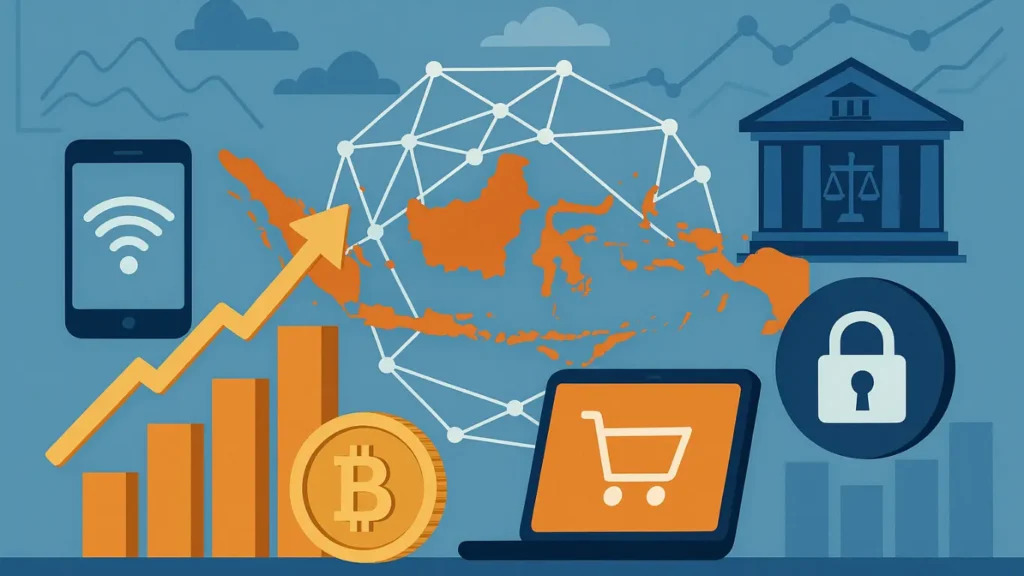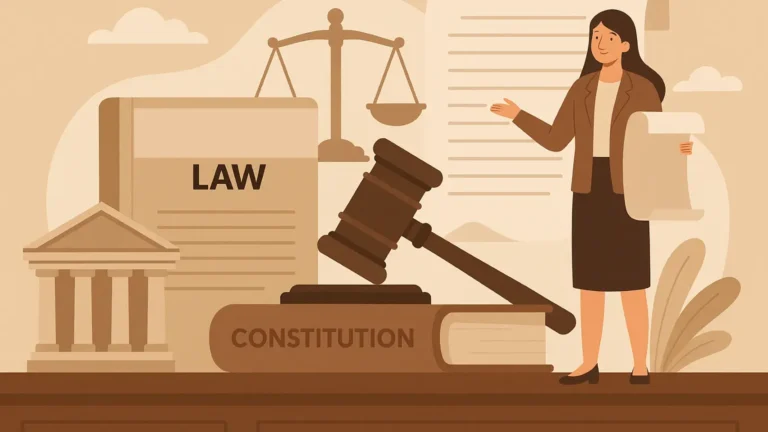
Daftar Isi
I. Background
Indonesia’s digital economy is one of the largest in Southeast Asia and is expected to grow steadily, reaching US$130 million by 2025, according to e-Conomy SEA 2024 reports from Google, Temasek, and Bain & Company. This development is the result of various local and digital innovations such as e-commerce, fintech, and online services, as well as the involvement of the government through various strategies and regulations such as Visi Indonesia Digital 2045 and Buku Putih Strategi Nasional Pengembangan Ekonomi Digital Indonesia 2030.1
Combining the country’s growing youth population and internet availability, Indonesia’s digital economy might promote progress in the face of the looming economic downturn. The impressive 414% growth of Indonesia’s digital economy between 2017 and 2021 is evidence that fintech and e-commerce continue to dominate the country’s digital economy. Additionally, it is expected to expand by almost 62% between 2021 and 2025.2
Indonesia’s fast growth of information and communication technology has led to an unavoidable digital economic change. Progress has led to significant changes in several sectors of society, including commercial practices, public consumption, and governance. Indonesia, having the biggest population in Southeast Asia, has significant potential for the digital economy due to high internet exposure and a youthful, technologically adept demographic.3
Observing the increasing level of digitalization in developing nations, it is evident that using digital technology effectively is a way to boost national economic growth. Indonesia has a variety of digital roadmaps and master plans that are developed by various institutions. In the context of national digital development, cooperation is required from all four pillars: digital infrastructure, digital economy, digital government, and digital society.4
Baca juga: Mengurai Simpang Jalan Hukum Lingkungan Indonesia di Tengah Tekanan EUDR
The government is optimistic that 30 million MSMEs will enter the digital ecosystem by 2024. With more than 27 million MSMEs already going digital, the most important thing is not just going digital, but how MSME products can be sold and become champions in the digital market. One of the key points is pushing this digital economy to be inclusive. This means that the informal sector also needs to be included, for example, through the use of QRIS in wet markets and conventional trade. This is crucial so that MSMEs can continue climbing up the market ladder in the future.5
Minister of Trade Regulation No. 31 of 2023 concerning Business Licensing, Advertising, Guidance, and Supervision of Business Actors in E-Commerce (MOTR 31/2023) was issued as part of the government’s efforts to accelerate digital transformation in the trade sector. This regulation also aims to strengthen consumer protection and create a more equitable and competitive business climate for all business actors.6
The rise of the digital economy has influenced the global economic route, including Indonesia. This trend has gotten a lot of attention since the rise of digital services, notably in e-commerce, which connects more producers and customers, hence creating job chances. The administration also intends the use of e-government, smart city, and e-tax to improve public services.7
In the context of foreign policy, Indonesia is currently seeking to join the OECD (Organisation for Economic Co-operation and Development) and BRICS (Brazil, Russia, India, China, and South Africa), two economic blocs with different approaches to digital economy governance. The decision to join these entities is not merely a matter of diplomacy but will also have a direct impact on digital economic policy, infrastructure regulation, and investment models to be implemented domestically.8
The core of Indonesia’s digital transformation is the use of the Digital Public Infrastructure (DPI), which integrates digital identification processes, authentication protocols, and data exchange. DPI ensures that services such as social protection, population and civil registration, and health care are accessible, transparent, and responsive to the needs of the community.9
As an immense nation, Indonesia must ensure that digital freedom spreads from the center to the provinces. Digital transformation involves not only technology, but also sovereignty and fair growth.10
In light of these developments, it is clear that Indonesia’s digital economy has grown rapidly without an equally comprehensive regulatory structure. The emergence of redundant and fragmented rules highlights the critical need for a thorough examination of the current legal framework. This legal review aims to critically explore the fundamental difficulties in the evolution of Indonesia’s digital economy regulation and make tangible inputs for creating a more integrated, flexible, and future-oriented framework. The analysis is divided into two parts: first, an examination of the regulatory obstacles that impede efficient governance, and second, a series of recommendations for improving Indonesia’s digital economy regulation in accordance with both national priorities and global best practices.
II. Analysis
1. Navigating the Challenges of Digital Economy Regulatory Transformation in Indonesia
One of the fundamental elements in digital economic growth is the existence of Digital Public Infrastructure (DPI). DPI refers to digital systems that support economic and social services, including digital identity, electronic payments, and widely accessible and standardized data sharing systems.11
However, Indonesia still lags behind in DPI development. Currently, the existing digital identity system is not fully integrated with various financial and public services. Meanwhile, the digital payment system is still fragmented and has not achieved an optimal level of interoperability. To overcome these obstacles, Indonesia needs to accelerate the development of a DPI ecosystem that is compatible with global standards, yet flexible enough to adapt to domestic needs. Regulations that support interoperability between fintech services and national payment systems need to be drafted immediately. In addition, the development of a national digital identity that can be used in various transactions, both in the public and private sectors, must be a priority.12
Indonesia’s Digital Public Infrastructure (IPD) refers to an ecosystem of integrated and secure government digital services, aimed at improving efficiency, transparency, and public access to services such as population, health, and social protection. This initiative is accelerated through the launch of INA Digital as GovTech Indonesia and collaborations such as with UNDP to support digital transformation, as well as data management efforts through programs such as Satu Data Indonesia.13
The implementation of IPD is also driven by the Indonesia Digital 2045 vision to realize Indonesia Emas through digitalization. In order to achieve more efficient public services and the development of integrated national digital infrastructure, the National Economic Council (DEN) and the United Nations Development Programme (UNDP) Indonesia, signed a Statement of Intent (SoI) to advance Indonesia’s digital transformation through the Digital Nusantara initiative. Digital Nusantara is DEN’s initiative to realize an integrated digital public service system.14
While programs like Digital Nusantara seek to reinforce the foundation of Indonesia’s digital ecosystem by integrating governmental services and infrastructure, these efforts unavoidably raise new data security and privacy concerns. As digitization broadens the scope of contacts between the state, enterprises, and individuals, personal data protection becomes not merely a technological requirement, but also a critical pillar in maintaining confidence in the digital economy. Protecting personal data has become a more urgent concern in light of the vast opportunities presented by the digital economy.15
Moving forward, the government is anticipated to amend and revise digital economy legislation in response to technical advancements and market values. An adaptive, collaborative, and risk-based approach is critical to ensure Indonesia’s digital economy thrives sustainably and benefits every stakeholder.16
To address this issue, the Indonesian government enacted the Personal Data Protection Law (PDP Law). However, there are still a number of barriers to the PDP Law’s implementation, including the regulatory institutions’ limited capabilities, the inadequate enforcement of the law, and the general public’s and businesses’ ignorance of the significance of protecting personal data. Building a secure and equitable digital ecosystem requires cooperation between the public and commercial sectors in addition to the regulatory component. This collaboration is required to enhance digital literacy, fortify infrastructure, and develop technologies focused on data security and consumer protection.17
Moving forward, the government is anticipated to amend and revise digital economy legislation in response to technical advancements and market values. An adaptive, collaborative, and risk-based approach is critical to ensure Indonesia’s digital economy thrives sustainably and benefits every stakeholder.18
2. Legal Reform Strategies for Advancing Indonesia’s Digital Economy
As the volume of digital transactions grows, several challenges may arise, including enforcing laws against infractions and supervision of digital business actors globally.19 The Electronic Information and Transactions Law (UU ITE) are a key rule for digital economic activity, although its implementation currently confronts challenges.20
There is a notable discrepancy between stated regulations and actual legal requirements when comparing Indonesia’s regulatory environment to international standards. For example, the adoption of the Personal Data Protection Law (UU PDP) represents a step forward in fortifying data protection safeguards, even if the UU ITE regulates electronic transactions. However, there are still issues with its execution, such as the legal infrastructure’s preparedness, digital business actors’ compliance, and law enforcement’s response to data breaches.21
In contrast, nations like the European Union have put in place more extensive laws, such the General Data Protection Regulation (GDPR), which establishes a global standard for data security and privacy. Despite its advancements, Indonesia’s regulatory structure still needs to be improved to conform to global best practices. In a similar vein, digital taxes are still a problem in Indonesia, while industrialized countries have put in place more accurate and organized systems for taxing global digital firms.22
Digitalization is not just about technology, but also about trust. The system that is built must be accurate, secure, and accessible to all citizens without discrimination. The government continues to move forward with its major national digital transformation agenda, particularly in its efforts to reform the social protection system. Through the Coordination Meeting for the Preparation of the Digital Public Infrastructure (DPI) Pilot Project for the Use Case of Social Assistance for the Family Hope Program (PKH), stakeholders from various ministries and institutions agreed on the strategic steps to be taken. Digital Public Infrastructure (DPI), which includes Digital Identity (IKD), data exchange between agencies through the Government Service Connection System (SPLP), and digital payment systems, is the main foundation for ensuring the inclusiveness, accuracy, and transparency of social assistance programs in the future.23
The Deputy Minister of Digital Transformation at the Ministry of Administrative and Bureaucratic Reform, Cahyono Tri Birowo, emphasized that this pilot program is part of the acceleration of the President’s priority agenda in developing digital governance that has a direct impact on the community. The digitization of social protection is not just a technology project, but a strategic effort to improve the accuracy of aid distribution and increase public trust. He also emphasized the importance of the use case approach as a strategy to accelerate thematic digital transformation oriented towards direct services to the community.24
The government can operate with greater accuracy, efficiency, and transparency thanks to digitization. For the benefit of the country, the Ministry of National Development Planning/Bappenas is dedicated to creating this digitization plan. For digital transformation to continue on its current course, the government thus requires a solid data foundation and a well-defined national policy.25
Five suggestions have been developed by the Ministry of National Development Planning/Bappenas to hasten the country’s digital transformation, which includes:
- Creating dependable hardware as the transformation’s cornerstone.
- The development of software, such as cross-service super-apps.
- Enhancing human resource capacity to fortify brainware.
- Using cybersecurity defenses to secure the system at all levels, from the hamlet to the central area.
- Attaining digital independence to guarantee equal capability in every Indonesian region.26
Legal reform methods for growing Indonesia’s digital economy can be viewed as part of a larger endeavor to create a cohesive and future-ready legal ecosystem. Harmonizing fragmented norms, building institutional capacity, and pursuing an innovative yet protective approach will enable Indonesia’s digital economy to stay globally competitive while protecting consumer interests and supporting long-term prosperity. With such a broad agenda, Indonesia is better positioned to restructure its regulatory environment into one that promotes resilience, inclusivity, and long-term digital growth.
III. Conclusion
Due to the rapid expansion of Indonesia’s digital economy, new laws governing digital public infrastructure (DPI) are required in order to guarantee security, encourage creativity, and advance inclusivity. Important policy challenges include increasing high-speed internet access, boosting digital skills, developing national digital identification systems, promoting data privacy and consumer protection, and improving e-payment infrastructure through various programs. By placing a strong emphasis on cooperative ecosystems, forming strategic partnerships, and modifying legal frameworks to accommodate a changing digital environment, the government is working toward these objectives.
The growth of Indonesia’s digital advacement underscores the urgency of establishing a legal framework that is not only coherent but also responsive to rapid technological change. By addressing regulatory fragmentation and strengthening institutional capacity, Indonesia can build a more adaptive system that balances innovation with consumer protection and data security. A future based regulatory approach will be key to ensuring that digital transformation contributes to more equitable access, legal certainty, and sustainable national development, so that the digital economy truly becomes a driver of both social and economic progress.
Indonesia’s digital economy regulation is crucial for promoting national economic progress in the digital age. The government has implemented pro-innovation policies, improved digital infrastructure, and promoted collaboration across public and private sectors. Despite progress, many difficulties remain, including outdated rules, infrastructure deficiencies, and insufficient digital literacy in society. Harmonizing rules and building human resource capability are crucial for fostering an inclusive and competitive digital environment.
IV. Suggestion
In addressing regulatory transformation in Indonesia’s digital economy, it is essential to tackle challenges related to outdated consumer protection laws, incomplete data privacy and cybersecurity frameworks, significant infrastructure gaps, and a shortage of skilled digital workers. The solution involves establishing
clear and adaptive regulations for new business models, accelerating infrastructure development to address the digital divide, investing in comprehensive digital skills training, and encouraging ongoing collaboration between the government, regulators such as OJK and Bank Indonesia, and the private sector to create an environment that supports innovation.
The strategic legal reform to advance Indonesia’s digital economy should focus on harmonization of regulations through public-private dialogue, institutional reform for better governance, strengthening data protection and privacy, adapting fiscal policies to digital businesses, and promoting inclusive access to digital infrastructure and services to support MSMEs and vulnerable communities. The 2025 national strategy should have a main legal aim for significant digital transformation, emphasizing support for trade, consumer interests, and MSMEs. These notions are critical for Indonesia to build a coherent and future-ready digital economy regulation capable of balancing national interests and global integration.
- Google, Temasek, and Bain & Company, e-Conomy SEA 2022 – Through the Waves, Towards a
Sea of Opportunity (2022), https://economysea.withgoogle.com/home/. ↩︎ - Militcyano Samuel Sapulette and Pyan A. Muchtar, Redefining Indonesia’s Digital Economy, ERIA
Policy Brief, no. 2022-06 (Jakarta: Economic Research Institute for ASEAN and East Asia, January
2023). ↩︎ - Suratman Hukom and Nurma Humi, “The Urgency of Legal Regulation for Personal Data Protection
in Indonesia in the Big Data Era,” Hakim: Jurnal Ilmu Hukum dan Sosial 3, no. 1 (2025): 974–992,
https://doi.org/10.51903/hakim.v3i1.2291. ↩︎ - Indonesia Digital 2045, “Overview,” Digital2045.id, accessed September 24, 2025,
https://digital2045.id/overview/. ↩︎ - Kementerian Koordinator Bidang Perekonomian Republik Indonesia, Siapkan Guideline bagi
Transformasi Digital: Pemerintah Segera Luncurkan Buku Putih Strategi Nasional Pengembangan
Ekonomi Digital Indonesia 2030 (3 Desember 2023), https://www.ekon.go.id/publikasi/detail/5531/siapkan-guideline-bagi-transformasi-digital-pemerintah-segera-luncurkan-buku-putih-strategi-nasional-pengembangan-ekonomi-digital-indonesia-2030. ↩︎ - Sakurayuki Naila Amatullah and M. Haykal Armanto, “Indonesia’s white paper on digital
transformation,” HBT (Herbert Smith Freehills Kramer), March 3, 2025,
https://www.hbtlaw.com/insights/2025-03/indonesias-white-paper-digital-transformation, accessed
September 24, 2025. ↩︎ - SMERU Research Institute, Towards a More Inclusive Digital Economy: a Policy Review (2020)
https://smeru.or.id/en/research/towards-more-inclusive-digital-economy-policy-review, accessed
September 24, 2025. ↩︎ - Digital Transformation Indonesia, “Strategi Digital Indonesia: Antara Ekonomi Digital, Infrastruktur
Publik, dan Integrasi Global,” DigitalTransformation.co.id, 9 April 2025, https://digitaltransformation.co.id/strategi-digital-indonesia-antara-ekonomi-digital-infrastruktur-publikdan-integrasi-global/, accessed September 24, 2025. ↩︎ - United Nations Development Programme Indonesia, Indonesia Menuju Satu Sistem Digital: UNDP
dan DEN Tandatangani Statement of Intent untuk Percepat Transformasi Digital (Jakarta, 7 Juli 2025),
https://www.undp.org/id/indonesia/press-releases/indonesia-menuju-satu-sistem-digital-undp-dan-den-tandatangani-statement-of-intent-untuk-percepat-transformasi-digital, accessed September 24, 2025. ↩︎ - Kementerian PPN/Bappenas, “Support for Digital Public Infrastructure Will Accelerate National
Digital Transformation,” https://www.bappenas.go.id/id/berita-dan-siaran-pers/support-for-digital-public-infrastructure-will-accelerate-national-digital-transformation, accessed September 24, 2025. ↩︎ - Digital Transformation Indonesia, “Strategi Digital Indonesia. ↩︎
- Digital Transformation Indonesia, “Strategi Digital Indonesia. ↩︎
- United Nations Development Programme Indonesia, Indonesia Menuju Satu Sistem Digital. ↩︎
- United Nations Development Programme Indonesia, Indonesia Menuju Satu Sistem Digital. ↩︎
- John Smith, “The Development of the Digital Transformation of the Government of Indonesia,”
Journal of Digital Governance 8, no. 2 (2023): 123–140, https://doi.org/10.12345/jdg.v8i2.2868. ↩︎ - Smith, “The Development of the Digital Transformation,” 130. https://doi.org/10.12345/jdg.v8i2.2868 ↩︎
- N. Rizqiyanto, “Tax Regulation Challenges in the Digital Economy Era,” Trunojoyo Law Review 7,
no. 2 (2025), https://doi.org/10.25047/trunojoyolawreview.v7i2.28540. ↩︎ - Salfarina Samsudin and Fatin Afiqah Md. Azmi, “Balancing Innovation and Privacy: Regulatory
Frameworks for Data Protection in Indonesia’s Digital Economy,” International Journal of Law,
Government and Communication 10, no. 40 (2023), https://doi.org/10.35631/IJLGC.1040050 ↩︎ - E. Santoso, “Opportunities and Challenges: E-Commerce in Indonesia from a Legal Perspective,”
Jurnal Penelitian Hukum De Jure 22, no. 3 (2022): 395–410 ↩︎ - A. A. Ilmih, “Legal Protection of Personal Data Based on Electronic Transactions in the Era of the
Digital Economy,” in The 2nd International Conference and Call for Paper, vol. 1, no. 1 (2020). ↩︎ - David Bani Adam, “Journal of Law and Regulation Governance,” Journal of Law and Regulation
Governance 3, no. 4 (2025): 148–154. ↩︎ - Adam, “Journal of Law and Regulation Governance,” 150. ↩︎
- Kementerian PPN/Bappenas, “Membangun Fondasi Digitalisasi Perlindungan Sosial: Peran
Bappenas dan Satu Data Indonesia dalam Pilot Project DPI di Banyuwangi,” Bappenas.go.id, 14 Juni
2023, https://www.bappenas.go.id/id/berita-dan-siaran-pers/membangun-fondasi-digitalisasi-perlindungan-sosial-peran-bappenas-dan-satu-data-indonesia-dalam-pilot-project-dpi-di-banyuwangi, accessed
September 24, 2025. ↩︎ - Kementerian PPN/Bappenas, “Membangun Fondasi Digitalisasi Perlindungan Sosial. ↩︎
- Kementerian PPN/Bappenas, “Support for Digital Public Infrastructure. ↩︎
- Kementerian PPN/Bappenas, “Support for Digital Public Infrastructure. ↩︎




